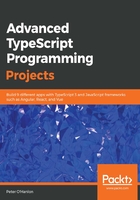
Building future-proof TypeScript with tsconfig
As TypeScript has grown in popularity, it has benefited from a rapidly evolving open source architecture. The design goals behind the original implementation means that it has proven to be a popular choice for developers, from those who were new to JavaScript-based development to seasoned professionals. This popularity means that the language has quickly gained new features, some straightforward and others geared toward developers who are working on the cutting edge of the JavaScript ecosystem. This chapter aims to address the features that TypeScript has introduced to match either current or upcoming ECMAScript implementations that you might not have encountered previously.
As we progress through this chapter, I will occasionally call out features that require a newer ECMAScript standard. In some cases, TypeScript will already have provided a poly-filled implementation of a feature that works with earlier versions of ECMAScript. In other cases, the version we compile against will have a feature that could not be back-filled beyond a certain point so it will be worth using a more up-to-date setting.
While it's possible to compile TypeScript completely from the command line using nothing but parameters, I prefer to use tsconfig.json. You can either create this file manually or have TypeScript create it for you using the following command from the command line:
tsc --init
If you want to copy my settings, these are the ones I have set up by default. When we need to update references, I will point out the entries that need to be added:
{
"compilerOptions": {
"target": "ES2015",
"module": "commonjs",
"lib": [ "ES2015", "dom" ],
"sourceMap": true,
"outDir": "./script",
"strict": true,
"strictNullChecks": true,
"strictFunctionTypes": true,
"noImplicitThis": true,
"alwaysStrict": true,
"noImplicitReturns": true,
"noFallthroughCasesInSwitch": true,
"esModuleInterop": true,
"experimentalDecorators": true,
}
}